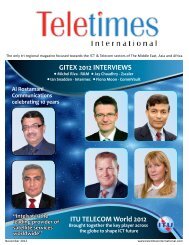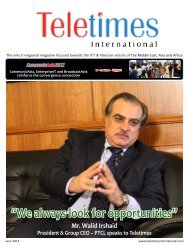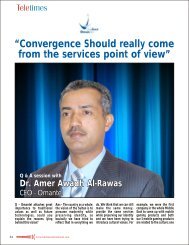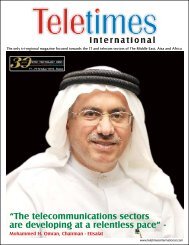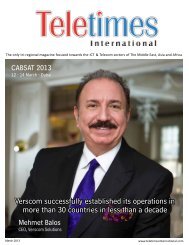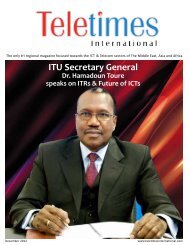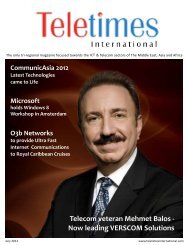You also want an ePaper? Increase the reach of your titles
YUMPU automatically turns print PDFs into web optimized ePapers that Google loves.
Using ICT to create cohesive, sustainable citiesThe Worldwatch Institute details how information and communicationtechnology (ICT) is promoting sustainable and inclusive citiesMore than half of theworld’s population lives inurban areas, and countries suchas India and China are in need ofhundreds of additional cities toaccommodate growing populations.People in many cities sufferfrom inadequate transportation,sub-standard buildings, lackof sanitation, and poor publicsafety, highlighting the need forDiana Lindsustainable and livable urbanplanning. Information and communicationtechnology (ICT) canbe a useful tool in helping citiesimprove their safety, cleanliness,and sustainability, according toDiana Lind, contributing authorto Worldwatch Institute’s Stateof the World <strong>2012</strong>: Moving TowardSustainable Prosperity.ICT not only contributes to sustainableurban initiatives, butalso encourages more environmentallyconscious consumerchoices. In Singapore, forexample, commuters can usemobile phones to avoid hoursin traffic by accessing data mappingtools that display trafficand provide alternate travelroutes. Commuters can alsoplan trips on public transportationand be notified of delays orchanges in service.“As cities try to become moresustainable, some municipalgovernments are finding outjust how useful ICT can be,”said Michael Renner, WorldwatchSenior Researcher andState of the World <strong>2012</strong> projectco-director. “Cities can be runmore intelligently with the helpof digital infrastructure, such asmotion-sensor street lamps andenergy chips in transit passesthat allow people to enter asubway or bus with the simpleswipe of a card.”In many cases, cities are partneringdirectly with businessesto boost urban sustainability.The Dutch city of Rotterdam,for example, is working withGeneral Electric (GE) in aneffort to reach the city’s goalof reducing carbon dioxideemissions by 50 percent comparedwith 1990 levels. GE willuse data visualizations, smartmeters, and other technologiesto optimize energy efficiencyand improve water management.The use of these ICTs willgreatly reduce greenhouse gasemissions in Rotterdam, whichemits as much carbon dioxideas New York City, while beingonly a tenth of its size.“ICT can be an excellent tool,but it is not the silver bulletsolution to greening cities,”said Lind, Executive Directorand Editor in Chief of NextAmerican City, a nonprofitthat promotes socially andenvironmentally sustainableeconomic growth in citiesin the United States. “To beeffective, ICT must be usednot only in mapping problemsencountered across cities,but also to find sustainablesolutions to those problems.”In Lind’s State of the World<strong>2012</strong> chapter, “Information andCommunications TechnologiesCreating Livable, Equitable,and Sustainable Cities,” shehighlights three ways that communitiescan effectively use ICTto promote sustainability:Open access to data. Improvingdata access is critical to creatingsustainable cities. By sharinginformation, it is possibleto make connections amongseemingly disparate variables.The Spatial Information DesignLab at Columbia University inNew York used data to establishthe connection betweencrime and poor housing,education, and health care. Byanalyzing data from the criminaljustice system, researchersfound that a disproportionatenumber of felons were fromspecific neighborhoods in largeU.S. cities. Similar research mayhelp officials target policiesaround education and povertyreduction in these areas, whichcould help in preventing crime.Community mapping: Mappingall neighborhoods and regionsof a city is vital to ensuringeffective and sustainable urbanplanning. Kibera, the largestslum in Kenya’s capital, Nairobi,is home to approximately 1million people. Yet Kibera hasbeen excluded from city maps,discounting its thousands ofresidents. Recently, an independentteam of researcherspartnered with Kibera youthto create an interactive map ofthe slums. In 2009, the teamsucceeded in placing Kiberaon official Nairobi maps, whichresulted in a new project, Voiceof Kibera, which helps citizensreport the location of robberiesor fires, and hold discussions bytext message.Community watch: ICTscan enhance communityinvolvement and helpauthorities respond tolocal concerns. The PublicLaboratory for OpenTechnology and Science, agrassroots-mapping communitybased in Cambridge,Massachusetts, uses low-techmaterials, including heliumballoons and digital cameras,to take aerial photos of areasthat may endanger publichealth or be of environmentalconcern. These tools helpedidentify contaminated areasin the Gulf of Mexico after amajor oil spill and an illegaldumping site in Brooklyn, NewYork. In addition, FixMyStreetin the United Kingdom orSeeClickFix in the United Statesare websites where peoplecan report concerns, suchas a burned out street light.Each problem is logged on thesite, making it easier for localgovernments to respond toissues of importance to thecommunity.Using ICT helps cities achievesustainability efficiently whileconnecting with local communities,to ensure that diverseperspectives are included in thecity’s plans.Worldwatch’s State of theWorld <strong>2012</strong>, focuses on thethemes of inclusive sustainabledevelopment discussed atRio+20, the 20-year follow-upto the historic Earth Summitof 1992, also held in Rio deJaneiro. The report presents aselection of innovative ideasand practices to achieve globalenvironmental sustainabilitywhile meeting human needsand providing jobs and ensuringdignity for all.56 <strong>October</strong> <strong>2012</strong>www.teletimesinternational.com





